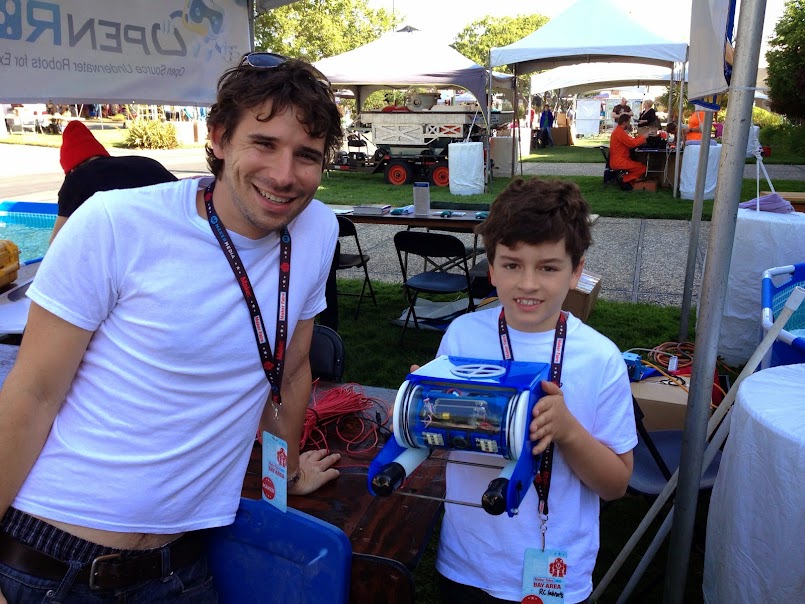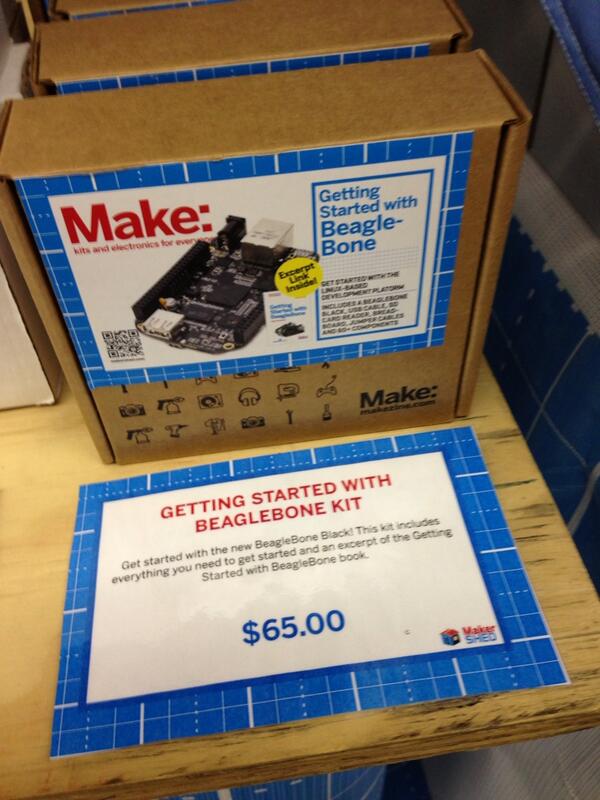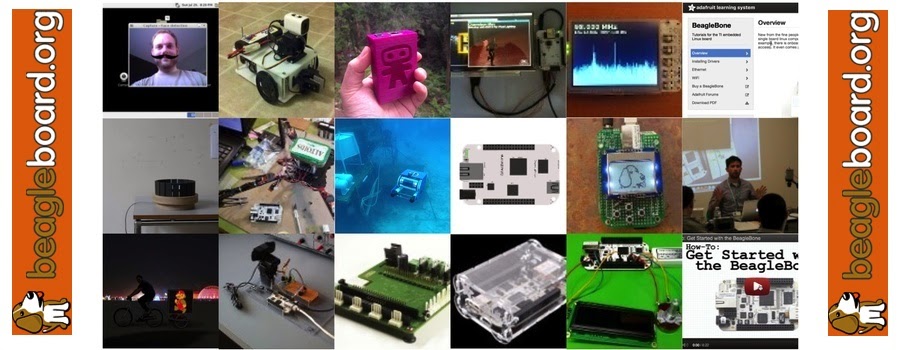Tuesday, July 30, 2013
New home for BeagleBoard.org blog
Monday, July 29, 2013
BeagleBoard.org celebrates 5 years of enabling Linux DIY hacks
BeagleBoard.org launched with support of Digi-Key in 2008 and DIYers quickly adopted BeagleBoard for migrating XBMC to ARM, building GPS accurate down to the centimeter, eight-legged robots and creating controller hacks. In 2010, Google Summer of Code students contributed numerous projects to help other open source developers, including sniffing USB traffic and XBMC performance optimizations. GSoC students are back at it again in 2013, providing solutions for booting BeagleBone from aNexus phone, running Arduino sketches and even building new peripherals out of an on-chip microcontroller.
With the introduction of BeagleBoard-xM in 2010, projects accelerated with homemade tablet computers, open graphing calculators, cluster computing in abriefcase,repurposed laptop LCDs, remote presence and versatile RC robots, space cameras, USB killswitches and wearable LED matrices. BeagleBoard-based wearables back in 2010 even provided a strikingly similarity to today's Google Glass.
BeagleBone Black is just getting its legs underneath it in its initial production run of 125,000 units with around half of those shipped so far. Early adopters were able to share some of their creations at Maker Faire, including LED strips being used to display live video. Beyond the obvious and popular lighting solutions, BeagleBone Black has found an early home in manufacturing solutions, especially with makers like Elias Bakken, who created the contest-winning Replicape 3D printer-enabling add-on board and a tiny HDMI display for use with BeagleBone Black, and Charles Steinkuehler, who has created the MachineKit software image containing LinuxCNC and Xenomi real-time Linux kernel. Both Elias and Charles have been steady contributors to the project of late and have helped enable several of the improvements making BeagleBone Black a complete and easy to use solution for all sorts of makers.
Tuesday, July 16, 2013
BeagleBoard.org GSoC 2013 update
First, the Beagle-ROS project...
...and now a bit on the project to add IIO support to the Linux mainline for the BeagleBone Black ADC...
The Userspace Arduino project has also made some excellent progress, demonstrating running Arduino sketches on BeagleBone Black...
The BeagleBoard Android Boot project has also produced successful bootloading from a Nexus phone.
Friday, June 14, 2013
BeagleBoard.org Google Summer of Code 2013 -- coding starts this Monday, June 17
BeagleBoard.org is just about to kick-off coding on our second time as a mentoring organization for Google Summer of Code. This is an amazing program that pays students for writing open source software over Summer. Seven (7) students will be participating in projects that advance the state of open source software for Beagle users and will earn them each US$5,000 if they are successful. Twenty-three (23) qualified mentors from the BeagleBoard.org community have volunteered to help the students reach their goals.
Each project has a page on BeagleBoard.org giving a bit of a description of the project linked in the table below. Each of those pages in turn links to blogs where the students will update the BeagleBoard.org community on their progress. Most of the daily collaboration will be happening on the #beagle-gsoc IRC channel, including weekly status meetings, which are all being logged. The nicknames of each student and mentor are included in square brackets in the table below, so you can contact them with any feedback you might have. You might also choose to join the BeagleBoard-GSoC Google Group for related announcements and additional technical discussion on the projects.
Each of the projects is rather interesting and you'll be able to read more about them here in the weeks to come. Scroll past the table below for a video describing one of the projects, the development of I2C drivers for the Minix operating system.
| Project | Student | Mentors (* = primary) |
|---|---|---|
| Minix I2C drivers for the BeagleBone Black | Thomas Cort (Heritage College in Canada) [tcort] | Kees Jongenburger* [keesj], Ben Gras [beng-nl], Frans Meulenbroeks [effem] |
| Arduino for userspace Linux | Anuj Deshpande (Pune Institute of Computer Technology in India) [hatguy_] and Parav Nagarsheth (Nirma University in India) [anujdeshpande] | David Anders* [prpplague], Matt Porter [mdp], Andrew Bradford [bradfa], Luis Gustavo Lira [lglira] |
| Android-based boot system | Vlad Victor Ungureanu (Jacobs University Bremen in Germany) [vvu] | Vladimir Pantelic* [av500], Tom King [ka6sox], Kees Jongenburger [keesj] |
| Software Defined Peripherals: JTAG/Debug via PRU | Jon Bailey (University of Waterloo in Canada) [jj2baile] | Tom King* [ka6sox], Andrew Bradford [bradfa], Pantelis Antoniou [panto], Hunyue Yau [ds2], Matt Ranostay [mranostay] |
| IIO, ADC, PMIC, LCD debug/patchwork | Zubair Lutfullah Kakakhel (University of Leeds in UK) [ZubairLK] | Greg Kroah-Hartman* [gregkh], Koen Kooi [koen], Vladimir Pantelic [av500], Tom Rini [Tartarus], Laine Walker-Avina [Ceriand] |
| Beagle-ROS | Víctor Mayoral Vilches (Universidad Rey Juan Carlos in Spain) [vmayoral] | Koen Kooi* [koen], Khem Raj [khem] |
One of the students has already posted a video describing their project and all of the students will eventually provide video presentations of their projects, so stay tuned if you want to be video-spoon-fed.
Thanks to Thomas for providing that video. Of course, there are several other individuals involved in supporting this year's Summer of Code, including, but certainly not limited to:
Our mentors-at-large: Derek Molloy (general BeagleBone) [molloyd], Mans Rullgard (ARM) [mru], Karim Yaghmour (Android), Russ Dill [Russ], Jason Kridner (BeagleBoard.org GSoC administrator) [jkridner] and
Our backup administrator (and all around amazing person): Cathy Wicks [cwicks].
Thanks to everyone for their participation and support. Looking forward to an amazing Summer!
--Jason
Tuesday, May 21, 2013
BeagleBone Black was a huge hit at Maker Faire!


Above on the left is the cover of Make Magazine and on the right is Eric Stackpole sharing
with a young explorer at the show what the OpenROV community has made.
Back on land, one of the physically largest, or at least tallest, exhibits at the show is also driven by BeagleBone. Benjamin James of coolneon.com about his BeagleBone based LED wall. The wall consists of over 1,000 LEDs fed by an SPI serial port from BeagleBone. BeagleBone is also performing animations and he even has a massive scale Tetris implementation written by Christopher De Vries where kids share the controls and need to cooperate to succeed. He's also got a mode that uses another computer connected to a Kinect camera to feed information to the BeagleBone such that the LED wall can be "conducted" as if in a concert. Benjamin is a huge BeagleBone fan looking to bundle up his LEDs and BeagleBone-based controller so that anybody can make some incredible light displays.

Above on the left is a picture of the BeagleBone-based LED exhibit to the left of a full concert stage. On the right is an interview I did with the maker, Benjamin James.
Benjamin wasn't the only one showing off LED lighting solutions using BeagleBone and sharing source. Paul Stoffregen of DorkbotPDX out of Portland, Oregon has a BeagleBone Black based LED display solution fed by stomp pads connected to his affordable Teensy microcontroller modules, a webcam and his open source software. Openness and performance were huge factors for Paul as he tried using another popular low cost computer and found it was dropping frames. That non-Beagle computer simply didn't have the performance he needed and he found it dropping frames---all problems that went away using BeagleBone. Another factor for his choice is the consistent build quality he's found using boards from Circuitco and BeagleBoard.org. He did much of his development on his laptop computer and was able to move his code over to Beagle without any hassles in about half-a-day. He also notes that BeagleBone Black ships with the video-4-linux (V4L) drivers that enabled easy use of a webcam to drive his LED array. You can read more about his experience on his dorkbotpdx blog post about getting ready for this event.
Above is a quick interview I did with Paul Stoffregen about his BeagleBone Black based LED display.
I was able to grab a couple of other quick interviews with BeagleBone Black users at Maker Faire, including Marcus Schappi of Ninja Blocks and Edouard Lafargue who built a model train exhibit. Both of these users are running Ubuntu, perhaps the most popular desktop Linux distribution, on BeagleBone Black (as opposed to the Angstrom Distribution image shipped with the boards). Because BeagleBone Black runs armv7 instructions, it can run the latest Ubuntu builds for ARM. Both of these projects are focused on connecting sensors and controls to a web interface. There are great community write-ups on getting Ubuntu installed on BeagleBone Black.
On the left is an introduction to Ninja Blocks. In the middle is a quick interview I did with Marcus Schappi of Ninja Blocks at Maker Faire. On the right, Edouard Lafargue shows off his BeagleBone Black based web controlled train.
 I spent much of my time at Maker Faire running around with my BeagleStache moustache camera running OpenCV. Below is a quick stache tweet I captured of Brian Jepson in the Maker Shed. While I was there, I also checked out the stock of BeagleBone Black. They didn't put out the BeagleBone Black boards until Sunday, but that didn't keep them from selling out before I managed to get back again. They also had a kit I haven't seen on-line yet that was $65 and included a pre-release preview of Matt Richardson's book "Getting Started with BeagleBone: Linux-Powered Electronic Projects With Python and JavaScript" and several other goodies including multiple breadboards and LEDs. The kits sold out as well.
I spent much of my time at Maker Faire running around with my BeagleStache moustache camera running OpenCV. Below is a quick stache tweet I captured of Brian Jepson in the Maker Shed. While I was there, I also checked out the stock of BeagleBone Black. They didn't put out the BeagleBone Black boards until Sunday, but that didn't keep them from selling out before I managed to get back again. They also had a kit I haven't seen on-line yet that was $65 and included a pre-release preview of Matt Richardson's book "Getting Started with BeagleBone: Linux-Powered Electronic Projects With Python and JavaScript" and several other goodies including multiple breadboards and LEDs. The kits sold out as well.At #makerfaire? Give @jadon your card for the chance to win @beagleboardorg #beagleboneblack or #badtothebone! twitter.com/BeagleStache/s…
— Boris Houndleroy (@BeagleStache) May 18, 2013
I had many great discussions with other people showing me their BeagleBoard.org related projects including stuff they had now and stuff they were creating. A tremendous thanks to Hunyue Yau for doing so much to educate people about BeagleBoard.org with his BeagleBone-based ProtoBone Android tablet prototype. Hunyue focused his booth on BeagleBoard.org activities and answered question after question after question about BeagleBoard.org and BeagleBone. He was also kind enough to share his space with a couple of volunteers from Ansync Automation, Sam Miller and Tom, who partnered up with Uncanny Vision to demonstrate a BeagleBone-based robot using Ansync's motor controllers and Uncanny Vision's UncannyCV. They created a really cool and powerful color tracking robot that gave dozens of aspiring young makers joy in following them around on the expo floor and making its R2-D2 sound effects.

Above on the left is Hunyue Yau's ProtoBone BeagleBone-based Android tablet prototype. On the right is a video of Tom describing the Ansync BeagleBot.
Another huge thanks goes to Drew Fustini, who frequently played host to Jessica and I, introducing us to many of the great makers that he knows and bringing the whole Texas Instruments crew out to Jeri Ellsworth's Bring-a-hack event. Drew brought a hack he got from the BeagleBoard.org community: an RF spectrum analyzer running on BeagleBone Black with a USB connected $25 receiver.
Above on the left is Drew Fustini. In the middle is a picture he took of the TIers going to Jeri's Bring-a-hack event. On the right is the RF spectrum analyzer Drew demonstrated at the event.
The whole experience was once in a lifetime and I never want to miss another Maker Faire. If you've ever thought about making something, anything, I really, really encourage you to register your idea on beagleboard.org/project, tell people about it on Google+ and the BeagleBoard.org Google Group getting their collaboration as needed, then propose it to one or more of the upcoming US Maker Faires or even the inaugural Maker Faire Europe in Rome still accepting applications until June 2nd. Happy Beagling!
Monday, February 25, 2013
BeagleBoard.org at ELC and SCaLE
Now is a great time for BeagleBoard.org and a great time to get involved. I am looking for more contributors to:
- the mainline kernel effort with patches being staged at http://github.com/beagleboard/kernel,
- support for the mainline kernel for doing physical computing in JavaScript at http://github.com/jadonk/bonescript,
- improvements to the distro used to make the boards useful out-of-the-box at http://www.angstrom-distribution.org/building-angstrom and
- support in any of Linux distribution or other operating systems.
Update: I corrected the blog post to say "most passionate" not "favorite" and added the link provided by Russ Dill.
Tuesday, November 13, 2012
BeagleBone and Linux seeking cure to hardware black magic
Embedded Linux Conference Europe (ELC-E) 2012 wrapped up last week in Barcelona. By far, the most popular embedded platform of choice for demonstrations was BeagleBone. Here are four examples that include links to the slides taken from the eLinux wiki ELC-E presentation page. Videos of the presentations should be available from Free Electrons soon.

Matt Porter of Texas Instruments stepped away from sensors and controls bringing back the Commodore 64 demoscene with "What's Old Is New: A 6502-based Remote Processor". While this might seem like a bit of a throw-back, many modern issues and solutions were explored to give us this taste of the past, including the Linux remoteproc/virtio interfaces to remote processors, the AM335x PRUSS processor that is extremely adept at bit-banging and the Fritzing design tool. Matt has also shared a picture of his wiring handy-work.
Finally, Koen Kooi of CircuitCo presented on one of the fundamental BeagleBone challenges, "Supporting 200 Different Expansionboards: The Broken Promise of Devicetree". If you frequent #beagle, you probably already know that Koen isn't easy to please and so the title shouldn't be much of a surprise. You might then be surprised to note on the first slide where "broken" has been scratched out! We certainly aren't there yet, but the device tree maintainers and AM335x kernel developers are starting to address the unique opportunities around BeagleBone cape expansion boards in the mainline Linux kernel, making a reality out of the dream of supporting hundreds of boards with a single kernel distributed ahead of the add-ons!
The continued enthusiasm of the embedded Linux community is just one element of what makes BeagleBoard.org successful, but it probably makes me happier than any other. With many of these developers moving the state of the Linux kernel ahead and even looking at sharing their hardware ideas in the BeagleBone Cape Plug-in Board Design Contest, I see a bright future where the largest collaborative software project of all time fully embraces the hardware and maker communities such that we can build a world where individuals and even children can reproduce electronics and computers down to the circuit level, not simply build on black magic.







